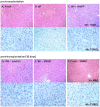A simplified subnormothermic machine perfusion system restores ischemically damaged liver grafts in a rat model of orthotopic liver transplantation
- PMID: 23369351
- PMCID: PMC3552573
- DOI: 10.1186/2047-1440-1-6
A simplified subnormothermic machine perfusion system restores ischemically damaged liver grafts in a rat model of orthotopic liver transplantation
Abstract
Background: Liver donor shortages stimulate the development of strategies that incorporate damaged organs into the donor pool. Herein we present a simplified machine perfusion system without the need for oxygen carriers or temperature control, which we validated in a model of orthotopic liver transplantation.
Methods: Rat livers were procured and subnormothermically perfused with supplemented Williams E medium for 3 hours, then transplanted into healthy recipients (Fresh-SNMP group). Outcome was compared with static cold stored organs (UW-Control group). In addition, a rat liver model of donation after cardiac death was adapted using a 60-minute warm ischemic period, after which the grafts were either transplanted directly (WI group) or subnormothermically perfused and transplanted (WI-SNMP group).
Results: One-month survival was 100% in the Fresh-SNMP and UW-Control groups, 83.3% in the WI-SNMP group and 0% in the WI group. Clinical parameters, postoperative blood work and histology did not differ significantly between survivors.
Conclusion: This work demonstrates for the first time in an orthotopic transplantation model that ischemically damaged livers can be regenerated effectively using practical subnormothermic machine perfusion without oxygen carriers.
Figures







References
-
- Human Resources and Services Administration. Organ Procurement and Transplantation Network and the Scientific Registry of Transplant Recipients: 2009 OPTN/SRTR Annual Report: Transplant Data 1999–2008 [ http://optn.transplant.hrsa.gov/ar2009/]
-
- Schleifer D. A simple heart-lung machine for the perfusion of small laboratory animals and for organ perfusion] [in German. Chirurg. 1967;38:477–480. - PubMed
-
- Guarrera JV, Henry SD, Samstein B, Odeh-Ramadan R, Kinkhabwala M, Goldstein MJ, Ratner LE, Renz JF, Lee HT, Brown RS Jr, Emond JC. Hypothermic machine preservation in human liver transplantation: the first clinical series. Am J Transplant. 2010;10:372–381. doi: 10.1111/j.1600-6143.2009.02932.x. - DOI - PubMed
Grants and funding
LinkOut - more resources
Full Text Sources
Other Literature Sources

